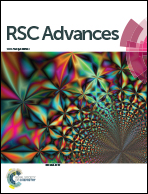Sulfanilic acid-functionalized silica-coated magnetite nanoparticles as an efficient, reusable and magnetically separable catalyst for the solvent-free synthesis of 1-amido- and 1-aminoalkyl-2-naphthols
Abstract
Sulfanilic acid-functionalized silica-coated nano-Fe3O4 particles (MNPs–PhSO3H) have been prepared as a reusable heterogeneous acid catalyst using a facile process. The catalytic performance of this novel material has been studied in the synthesis of 1-amido- and 1-aminoalkyl-2-naphthol derivatives via a one-pot three-component condensation reaction of aldehydes, 2-naphthol, and amides/urea/amines in good to excellent yields, under solvent-free classical heating conditions. The catalyst was easily separated from the reaction mixture with the assistance of an external magnetic field and reused for several consecutive runs without significant loss of its catalytic efficiency. Results obtained from transmission electron microscopy (TEM), scanning electron microscope (SEM), powder X-ray diffraction (XRD) and sample magnetometery (VSM) show that the synthesized magnetic nanocomposites are superparamagnetic with a size range of 15–30 nm.


 Please wait while we load your content...
Please wait while we load your content...